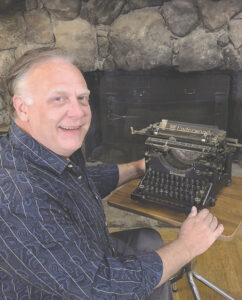The San Fernando Pass – #17400
The stagecoach rocked back and forth as it made its way north across the San Fernando Valley. A group of businessmen traveling from Los Angeles are in a bit of an argument.
“It can’t be done,” exclaimed one.
“I agree, it’s too steep,” said another.
But Harris Newmark, who had organized this excursion, knew the driver sitting up front better than the rest. He remarked, “I wouldn’t bet against Mister Banning.” The coach then came to a stop and the men began to disembark.
It’s December 1854 and, although it’s many years before there would be a Foothill Boulevard, these men were stepping out of this conveyance not far from today’s western extent of the roadway. In this, the first in a series of Historical Footnotes Along Foothill, we find ourselves at 17400 Foothill Blvd. where today’s story begins.
In 1854 Fort Tejon was established to the north. Mr. Phineas Banning wished to partake in the lucrative enterprise of transporting supplies there. One thing stood in his way: the San Fernando Pass. There had been a Native American pathway through these mountains, crossing at the lowest and most practical spot. Even still, it was steep and treacherous.
Harris Newmark addressed the group: “Gentlemen, you know why you’re here. You’ve pledged $6,000 [$225,000 today] towards the improvement of this road.”
Phineas Banning chimed in, “But you haven’t paid it!”
Newmark continued, “Many of you have come to the conclusion that this pass is impassable by wagon train and therefore have only paid a fraction of the funds pledged.”
It’s easy to understand the misgivings of the group. Up until this point, no coach had been driven over the pass, but Banning had come prepared. He had recently taken delivery of the very first Concord Coaches in Los Angeles and he sat atop one. These were the finest of the day. They were built tough and their hull-like construction allowed them to take the shocks of the road like a ship rides the waves of the sea.
Up on his box, holding the reins of his six strongest horses, Banning began his ascent. To those left behind to lighten his load he exclaimed, “Watch we men!”
As the coach climbed the strain upon the horses became apparent. They snorted loudly as their muscles fought against gravity, lifting the heavy vehicle ever higher. Banning was a master driver and he guided them upward with tremendous skill. Amazingly, they reached the crest of the hill and the horses were pulled to a stop.
In just moments, the men caught up from behind and peered over the edge upon an even steeper, zig-zagged, boulder-strewn path to the bottom.
They began to warn Banning: “You must give up this idea of freighting over these mountains. It’s obvious that no passable road can be made here!”
With that, Banning cracked his whip and his loyal horses lurched forward. Down they went, crashing from side to side, sometimes the wheels lifting off the ground. The men groaned in fear as they watched from above. But Banning guided his hands and the feet of his team with the expertise of a modern-day racecar driver. They saw him with his foot pressed hard against the brake, slithering down that wild hillside until he disappeared in a cloud of dust. The yelling and crashing sounds continued. They came to a stop and as the dust cleared, Banning was at the bottom, his arm raised high in triumph.
Within days the rest of the funds arrived. Soon hundreds of workers came to cut the roadway down and improve it in every way. On Feb. 28, 1855, five fully loaded freight wagons, each pulled by a team of 10 mules, successfully made their way through the pass enroute to Fort Tejon.
And all of this happened just off Foothill Boulevard.

